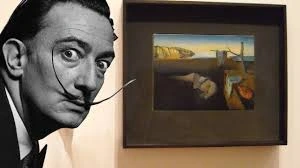
Prepare to delve into the captivating and often bizarre world of Salvador Dalí, one of the 20th century’s most iconic and enigmatic artists. Known for his melting clocks, flamboyant personality, and a mustache that became a work of art in itself, Dalí was a figure who consistently defied convention. Beyond the famous artworks and public eccentricities lies a life rich with fascinating details, personal beliefs, and unexpected influences that shaped his surreal vision. Join us as we uncover 27 intriguing facts about the master of Surrealism, Salvador Domingo Felipe Jacinto Dalí i Domènech, offering a deeper look into the mind and life of this unforgettable genius.
Salvador Dalí, whose full name was Salvador Domingo Felipe Jacinto Dalí i Domènech, was a Spanish Surrealist artist born in 1904. His complete name reflects his Spanish heritage and the traditional naming customs of the region, where individuals often carry multiple given names and their parents’ surnames. This detailed name gives insight into his family’s lineage and cultural background, which undoubtedly played a role in shaping his identity and artistic perspective.
A profound and somewhat unusual belief held by Salvador Dalí was that he was the reincarnation of his older brother, who had passed away nine months before Dalí’s birth. This conviction deeply influenced his psyche and artistic output, as evidenced by his painting titled Portrait of My Dead Brother. This belief suggests a complex psychological landscape, potentially fueling his unique perception of reality and his exploration of themes such as life, death, and identity in his art.
Dalí initially sought to align himself with the Surrealist movement, a group of artists and writers who explored the unconscious mind through various creative expressions. However, his association with the Surrealists was short-lived, as they eventually expelled him from the group. This expulsion was largely due to his controversial obsession with Adolf Hitler and his publicly expressed pro-fascist views, which clashed with the political leanings of many Surrealists, leading to irreconcilable differences.
In 1939, Dalí painted The Enigma of Hitler, a work that further highlighted his fascination with the dictator. His personal remarks about Hitler, such as, “I often dream of Hitler as a woman. His flesh, which I had imagined as whiter than white, ravish me . . . ,” reveal a deeply unsettling and complex psychological preoccupation that extended beyond mere political interest and delved into a more personal, almost eroticized, obsession.
Dalí’s upbringing was marked by a stark contrast between his parents: his father was described as very strict, while his mother was the exact opposite, showering him with deep affection. This dynamic parental influence, with the severity of his father and the profound love from his mother, is believed by some to have significantly contributed to the development of Dalí’s eccentricities and unconventional behaviors later in his life, shaping his unique personality and artistic expression.
Salvador Dalí’s life spanned 84 years; he passed away on January 23, 1989. His death marked the end of an era for the art world, concluding the life of one of the 20th century’s most iconic and controversial artists. Despite his advanced age, Dalí continued to engage with the art world and public, leaving behind a vast and influential body of work.
During his time at art school, Dalí demonstrated an early rebellious streak and an unwavering belief in his own genius, leading to two expulsions. The first expulsion was a result of his leadership in a student protest, showcasing his willingness to challenge authority. The second occurred when he famously refused to take his final exams, declaring to his examiners that he was more intelligent than they were, thus rendering it impossible for them to adequately assess him.
One of Salvador Dalí’s most iconic and universally recognized works is The Persistence of Memory. This painting, featuring melting clocks draped over various objects in a desolate landscape, has become one of the most famous artworks of all time. Its surreal imagery and profound symbolism, particularly regarding the fluidity of time, have captivated audiences and cemented its place in art history.
Dalí shared his life with an unusual companion, a pet ocelot named Babou, with whom he was inseparable. He famously took Babou with him everywhere, including to restaurants and social gatherings, creating a spectacle wherever they went. This peculiar pet choice further highlighted Dalí’s eccentric personality and his penchant for the unconventional, adding to his public persona as a unique and flamboyant artist.
Salvador Dalí held a notable obsession with money, which influenced his willingness to undertake a wide array of commercial projects. His financial motivation led him to accept nearly every endeavor that came his way, including the creation of the iconic logo for the lollipop company Chupa Chups. This commercial engagement showcases his ability to blend high art with popular culture, demonstrating his versatility and entrepreneurial spirit.
In a clever and unconventional attempt to save money, Salvador Dalí would often pay for goods and services with signed checks. He shrewdly recognized that business owners, valuing his autograph and the unique connection to the famous artist, would be hesitant to cash these checks, effectively preserving his funds while leaving behind a personalized piece of his legacy. This tactic highlights his ingenuity and understanding of his own public persona.
Dalí purchased a castle for his wife, Gala, located in Pubol, Spain, creating a private sanctuary for her. However, Gala imposed a unique condition on his visits: he was required to obtain written permission from her before he could enter. This arrangement speaks to the complex and unconventional nature of their relationship, highlighting Gala’s independence and her desire for personal space, even from her renowned artist husband.
Salvador Dalí held voyeuristic tendencies, reportedly enjoying the presence of other couples engaging in intimate relations. Furthermore, he encouraged his wife, Gala, to engage in sexual relationships with other men. Throughout her life, Gala had numerous extramarital affairs, notably including a continued relationship with her ex-husband, Paul Eluard, underscoring the unconventional and open nature of their marriage.
Dalí’s mother, Felipa Domènech Ferrés, passed away from uterine cancer when he was 16 years old. He described this event as “the greatest blow that I had experienced in my life,” indicating the profound impact it had on him. Adding another layer of complexity to his family life, his father later married Felipa’s sister, further shaping Dalí’s early experiences and emotional landscape.
In June 2017, Salvador Dalí’s remains were exhumed from his tomb in Figueres, Spain, for the purpose of a paternity test. This extraordinary measure was taken to ascertain if a claimant was indeed his daughter. The test ultimately proved negative, confirming that the woman was not his biological child, and she was subsequently ordered to bear the costs associated with the exhumation.
Food frequently served as a central and symbolic motif in Dalí’s artwork, representing themes of sex and beauty. Among the most common food items incorporated into his surrealist compositions were bread, eggs, cheese, and sea urchins. These everyday sustenance items were transformed into powerful symbols within his dreamlike landscapes, reflecting his unique perspective on desire, sensuality, and the human condition.
The iconic melting watches featured in many of Dalí’s works, particularly The Persistence of Memory, are widely interpreted as an artistic echo of Albert Einstein’s theory that time is relative rather than a fixed concept. The inspiration for this groundbreaking artistic idea reportedly came to Dalí while he was contemplating a piece of Camembert cheese, demonstrating his ability to draw profound artistic insights from seemingly mundane observations.
The theories of the renowned psychoanalyst Sigmund Freud, particularly his ideas on sexual repression and psychoanalysis, exerted a significant influence on Salvador Dalí’s artistic endeavors. Freud’s exploration of the subconscious mind, dreams, and the complexities of human desire deeply resonated with Dalí’s own artistic pursuits, providing a framework for his surrealist explorations and his unique visual language.
Salvador Dalí harbored a profound and debilitating fear of grasshoppers, a phobia so intense that some historians speculate he may have suffered from Ekbom’s syndrome. This psychiatric disorder causes individuals to experience tactile hallucinations, leading them to believe that insects are crawling beneath their skin, which could explain the extreme nature of Dalí’s aversion to grasshoppers.
Dalí’s parents observed a striking resemblance between Salvador and his deceased older brother, noting they were “like two drops of water but with different reflections.” Further emphasizing this connection, they even bestowed upon both their sons the exact same first name, “Salvador,” highlighting a profound desire to acknowledge and perhaps perpetuate the memory of their first child through their second.
According to Dalí’s own recollections, his childhood aspirations were quite distinct. At the tender age of six, he declared his ambition to become a cook, suggesting an early fascination with creation and transformation. Just a year later, at the age of seven, his aspirations shifted dramatically as he expressed a desire to be Napoleon, revealing an early inclination towards power and grandiosity.
Dalí humorously recounted that he wet the bed until he was eight years old, not due to any physical ailment, but simply for the “sheer fun of it.” This anecdote, if true, provides a glimpse into his playful and rebellious nature from an early age, suggesting a deliberate defiance of conventional norms and a unique perspective on childhood mischief.
Salvador Dalí’s iconic mustache, a defining feature of his public persona, was most likely inspired by the elaborate facial hair of the Spanish Golden Age painter Diego Velázquez. This artistic homage highlights Dalí’s deep respect for historical masters and his desire to connect with and reinterpret artistic traditions, adding a touch of theatricality to his own image.
In 2010, Salvador Dalí’s distinctive mustache achieved remarkable recognition, being named the most famous mustache of all time. This accolade speaks to the enduring power of his image and the way his unique personal style became synonymous with his artistic genius, making his facial hair a cultural icon in its own right, recognized globally.
After suffering severe burns in a fire at his home in 1984, Salvador Dalí’s health significantly declined, leading to him being confined to a wheelchair until his death in 1989. This unfortunate accident marked a tragic turning point in his later years, limiting his physical mobility but not dimming his spirit entirely, as he continued to be an artistic force even in his final years.
A significant portion of Salvador Dalí’s most influential and recognized artworks were created before he reached the age of 35. This period of intense creative output produced many of the pieces that define his legacy, showcasing his early genius and the rapid evolution of his surrealist style during his formative artistic years.
Dalí meticulously designed and constructed his own museum, the Dalí Theatre-Museum in Figueres, Spain, a testament to his unique vision and enduring legacy. Following the fire that injured him, he moved into the museum, transforming it into his final residence. He subsequently passed away within the very walls that housed his extraordinary artistic achievements, making the museum his ultimate resting place and a permanent monument to his life’s work.
Born in Spain in 1904, Salvador Dalí later embarked on a significant journey to Paris in 1929, a pivotal move that profoundly influenced his artistic development. It was in Paris that he sought to immerse himself in the vibrant artistic scene and to study directly with the Surrealists, ultimately leading to his integration, albeit briefly, into the movement that would define his most famous works.
Among Salvador Dalí’s personal artistic inspirations was The Lacemaker by the Dutch artist Jan Vermeer (1632-75). This preference reveals Dalí’s appreciation for the meticulous detail and subtle beauty found in classical art, demonstrating that even a pioneering surrealist could find profound inspiration in the works of earlier masters.
Salvador Dalí harbored a deep fascination with Albert Einstein’s theories of time and space, particularly his groundbreaking theory of relativity. This scientific concept, which posits that time is not fixed but rather flows and changes according to circumstances, profoundly influenced Dalí’s artistic explorations, leading to his iconic depictions of melting clocks and the fluidity of time in his surrealist landscapes.
Horrified by the brutal destruction and human suffering inflicted during the Spanish Civil War, Salvador Dalí channeled his anguish into the painting Autumn Cannibalism. This powerful and disturbing work depicts two monstrous human beings engaged in the act of consuming each other’s bodies, serving as a visceral and symbolic representation of the self-devouring nature of civil conflict and the profound despair it engendered.
Frequently Asked Questions about Salvador Dalí
1. What was Salvador Dalí’s full name? Salvador Dalí’s full name was Salvador Domingo Felipe Jacinto Dalí i Domènech. He also held the title of Marquess of Dalí of Púbol GYC later in life. This lengthy name reflects Spanish naming traditions, which often include multiple given names and both paternal and maternal surnames. It highlights his Spanish heritage and the formal aspects of his identity, even amidst his famously unconventional persona.
2. What inspired Dalí’s melting clocks in “The Persistence of Memory”? The iconic melting clocks in Dalí’s most famous painting, The Persistence of Memory (1931), were reportedly inspired by his contemplation of a piece of Camembert cheese melting in the sun on a hot August day. This mundane observation sparked his artistic imagination, leading him to visualize time as fluid and relative, rather than fixed and rigid. This concept also aligns with Albert Einstein’s theory of relativity, which greatly fascinated Dalí and influenced his exploration of time and space in his art. The painting is a powerful visual representation of the fleeting nature of reality and the subjective experience of time.
3. Was Salvador Dalí expelled from art school? Yes, Salvador Dalí was expelled from art school twice. The first expulsion occurred when he led a student protest, demonstrating his early rebellious nature. The second, and perhaps more famous, expulsion happened when he refused to take his final exams. He declared to his examiners that he was more intelligent than they were, making it impossible for them to examine him. These incidents underscore his immense self-belief and his consistent challenge to authority and conventional norms from a young age.
4. What was Salvador Dalí’s relationship with the Surrealists? Dalí initially sought to join the Surrealist movement in Paris in 1929, drawn by their exploration of the subconscious and dream imagery, which resonated deeply with his own artistic inclinations. He became a prominent member and a significant contributor to the movement, even developing his “paranoiac-critical method” to induce hallucinations and access his subconscious for creative inspiration. However, his relationship with the group, particularly with its leader André Breton, became strained. Dalí was eventually expelled in 1934 and definitively in 1939 due to his controversial fascination with Adolf Hitler and his perceived pro-fascist political views, which clashed with the left-leaning, anti-fascist stance of most Surrealists. Despite his expulsion, Dalí famously stated, “The only difference between me and the Surrealists is that I am a Surrealist,” indicating his belief that his art remained true to the movement’s core principles.
5. Did Salvador Dalí have a pet? What kind of pet was it? Yes, Salvador Dalí famously had a pet ocelot named Babou. He acquired Babou in the 1960s and would take the exotic cat with him almost everywhere, including to restaurants and on transatlantic voyages. This unconventional choice of pet further solidified his eccentric public image and demonstrated his penchant for the dramatic and unusual. He was also photographed with an anteater on a leash on one occasion.
6. Did Salvador Dalí design the Chupa Chups logo? Yes, Salvador Dalí designed the iconic logo for the Spanish lollipop company Chupa Chups in 1969. The design features the brand name in a bright, daisy-like shape. Dalí’s genius extended beyond just the visual design; he also advised the company to place the logo on top of the lollipop wrapper instead of the side, ensuring that it would always be seen intact and clearly visible, a shrewd marketing insight.
7. Did Salvador Dalí die in a fire? No, Salvador Dalí did not die in a fire, but he was severely injured in one. In 1984, an electrical fire broke out in his home at Púbol Castle, where he had been living since his wife Gala’s death. He suffered severe burns, which significantly impacted his health and left him confined to a wheelchair for the remaining years of his life. He died at the age of 84 on January 23, 1989, in Figueres, Spain, at the Dalí Theatre-Museum, which he had designed himself.
8. When did Salvador Dalí die? Salvador Dalí died on January 23, 1989, at the age of 84. He passed away in his hometown of Figueres, Spain, within the Dalí Theatre-Museum, a building he had personally conceived and designed to house his works.
9. What was Salvador Dalí’s family life like, and who were his parents? Salvador Dalí’s family life was complex and profoundly influenced his artistic and personal development. His full name was Salvador Domingo Felipe Jacinto Dalí i Domènech, and he was born to Salvador Dalí i Cusí, a strict notary, and Felipa Domènech Ferrés, a deeply affectionate mother who encouraged his artistic talents. A significant aspect of his early life was the belief, fostered by his parents, that he was the reincarnation of his older brother, also named Salvador, who had died nine months before Dalí’s birth. This notion had a profound psychological impact on him, shaping his identity and appearing as a theme in his work, such as Portrait of My Dead Brother. His mother died from uterine cancer when he was 16, a loss he described as “the greatest blow that I had experienced in my life.” His father later married his mother’s sister, further complicating the family dynamic.
10. Why was Salvador Dalí considered controversial? Salvador Dalí was controversial for several reasons. His pro-fascist leanings and public admiration for Adolf Hitler deeply alienated him from the mostly left-leaning Surrealist group, leading to his expulsion. He was also known for his extreme eccentricities and provocative public stunts, which some saw as brilliant performance art and others as mere attention-seeking. His private life, including his voyeuristic tendencies and open marriage with Gala, was also a source of controversy. Furthermore, his later commercial endeavors, where he would take on nearly any project for money (earning him the nickname “Avida Dollars” – an anagram of his name meaning “greedy for dollars”), were criticized by some art purists.
11. What is Salvador Dalí’s most famous painting? Salvador Dalí’s most famous painting is arguably “The Persistence of Memory” (1931). This small, yet incredibly impactful, oil painting featuring melting clocks in a desolate landscape has become an iconic image of Surrealism and one of the most recognized artworks of the 20th century. Its imagery has been widely reproduced and referenced in popular culture.
12. What were some major influences on Salvador Dalí’s art? Salvador Dalí’s art was influenced by a diverse range of sources:
- Psychoanalysis: The theories of Sigmund Freud, particularly on the unconscious mind, dreams, and sexual repression, were a profound influence. Dalí sought to visually represent the hidden desires and anxieties of the subconscious.
- Scientific Theories: Albert Einstein’s theory of relativity and the concepts of time and space deeply fascinated him, leading to the melting forms in his work.
- Childhood and Personal Beliefs: His belief in being the reincarnation of his deceased brother, his complex relationship with his parents (the strict father and affectionate mother), and his vivid childhood dreams significantly shaped his thematic content.
- Classical Masters: Despite his revolutionary style, Dalí greatly admired and drew inspiration from Old Masters like Diego Velázquez (whose mustache inspired Dalí’s own) and Jan Vermeer, appreciating their technical skill and meticulous detail.
- Food: Common food items like bread, eggs, cheese, and sea urchins frequently appeared in his works, often symbolizing sex and beauty.
13. Was Salvador Dalí afraid of anything unusual? Yes, Salvador Dalí was famously and intensely afraid of grasshoppers. This phobia was so severe that some historians suggest he may have suffered from Ekbom’s syndrome, a psychiatric disorder that causes individuals to believe insects are under their skin. He even incorporated ants into some of his paintings, possibly as a way to confront or express this deep-seated fear.
14. What were some of Salvador Dalí’s most bizarre habits? Dalí was a master of self-promotion and cultivated a public persona filled with bizarre habits:
- Voyeurism: He was a self-admitted voyeur who enjoyed watching other couples engage in intimate relations.
- Open Marriage: He had an unconventional and open marriage with his wife, Gala, and encouraged her to have affairs.
- Paying with Checks: He would often pay for goods and services with signed checks, knowing that due to his fame, many business owners would frame them rather than cash them, effectively saving him money.
- Eccentric Appearances: He made numerous public appearances dressed in outlandish costumes, often accompanied by unusual props, like an anteater on a leash, or a Rolls Royce filled with cauliflowers.
- Obsession with Hitler: His unsettling fascination with Hitler, including dreams and paintings, was considered highly bizarre and offensive by many.
- Bed-wetting: He claimed to have wet the bed until he was eight years old simply “for the sheer fun of it.”








